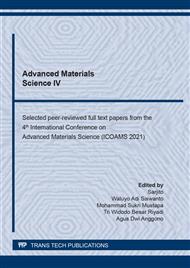p.24
p.31
p.41
p.51
p.58
p.64
p.71
p.79
p.89
Extraction of Flavonoid Compound of Bitter Melon (Momordica charantia L.) Fruit and Leaves Using the Soxhlet Method in Different Types of Solvent
Abstract:
Indonesia has great benefits as a tropical country where a wide variety of fruits, vegetables and other plants are found so that they have the potential to be a source of bioactive compounds such as flavonoid compounds. This research will study the effect of solvent polarity on the extraction of flavonoid bioactive compounds in bitter melon (Momordica Charantia L.) fruit and leaves using the Soxhlet method. The solvents used were non-polar (n-hexane), polar (ethanol), and semi-polar (ethyl acetate) with a concentration of 50% (v/v). Extraction was carried out at the boiling point of the solvent at various extraction times of 60, 90, 120, and 150 minutes with a sample to solvent ratio of 1:20 (w/w). From this research, it was known that ethyl acetate was able to extract bitter melon with the highest yield than n-hexane and ethanol, which was 36% at 90 minutes. The largest total flavonoid compound (TFC) was obtained in extraction using ethanol then n-hexane and ethyl acetate. In Soxhlet extraction, the semi-polar solvent (ethyl acetate) has the best performance on the yield, while the polar solvent (ethanol) was the best for extracting TFC compounds in the bitter melon fruit and leaves.
Info:
Periodical:
Pages:
58-63
Citation:
Online since:
January 2022
Keywords:
Price:
Сopyright:
© 2022 Trans Tech Publications Ltd. All Rights Reserved
Share:
Citation:


